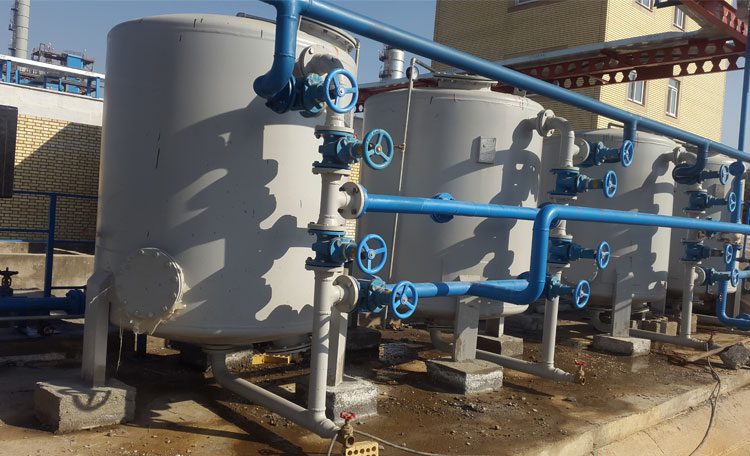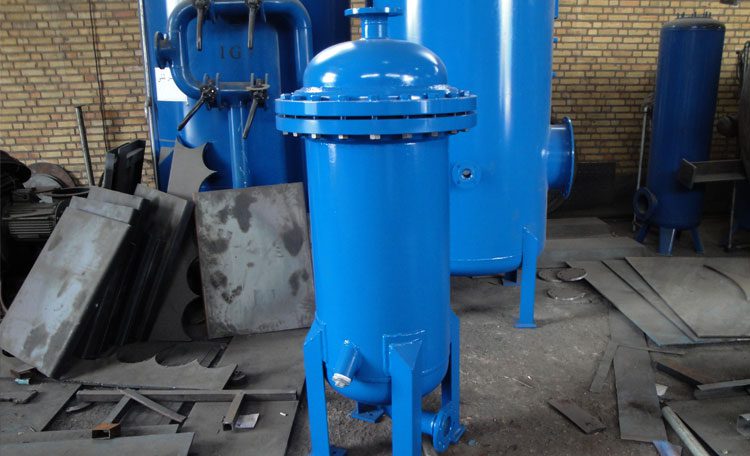Sand filter is one of the oldest and most common methods of water treatment that is used to remove suspended particles in the water with a size of more than 100 microns. Cheap price, efficiency and long life are among the positive features that have made sand filter water treatment widely used in domestic and industrial applications. Here are the types of sand filters, work routines, advantages and disadvantages, and everything you need to know about the price of sand filters. Join Haft Industrial Group and the sand filter production team.
What is a sand filter?
Water treatment in nature is done in various ways, one of the most important of which is the removal of waste products from the water by passing it through a sand bed. In designing and manufacturing sand filters, this nature-inspired behavior is less costly than other water treatment methods such as ultrafiltration and nanofiltration to remove suspended particles in water. Sand filters are actually a type of tank that has an inlet and an outlet valve and nozzles with sand and silica coating. Particles suspended in water will not pass through the filter and nozzle covered with sand grains, and eventually the water outlet will be clean and purified.
The body of sand filters is made of different materials, the most common of which are metal, fiberglass and concrete bodies. The metal bodies of this equipment are made of galvanized sheets and the type of concrete that is mostly used for high capacity refineries is made of concrete and is very strong. Fiberglass filters are made from pressed composites and are also known as FRP sand filters.
Water treatment method with sand filter
In general, without considering the different types of sand filters, how they work can be described as follows:
Water containing salts, iron, manganese, suspended particles of mud, etc. enters the tank from the inlet valve.
Inside the tank are provided nozzles covered with sand and silica. In order to prevent corrosion of the nozzles, the coating of sand and silica on the nozzles is done in such a way that first the grains are larger, then medium and finally fine grains. The passage of water through the nozzle causes particles larger than 100 microns to hit the grains of sand and do not allow the passage of the nozzles, and only water droplets pass through the nozzle without suspended particles.
Particle-free water is transferred from the tank outlet valve to the outside of the device and used.
Types of sand filters
A very important point in the design of a sand filter is the force that causes water to pass through the nozzle. Accordingly, and according to the amount of pressure applied to the water to pass through the filter, sand filters can be divided into several general groups, which are:
-
Slow Sand Filter
This type of sand filter is common in nature and operates without any pressure force. The passage of water through the sand bed at a completely natural and calm speed in an area of one square meter, in a day and night, finally produces 3 cubic meters of purified water. Due to the very low speed of this group of water treatment methods, it is mostly used for industrial and home environments where the need for treated water is low. For example, in rural water network treatment plants, sand filter can be a suitable and cost-effective option.
-
Rapid Sand Gravity Filter
This group of sand filters is very similar to the slow and quiet type, and the only difference is the area of the sand bed through which the water passes. In order to pass water with higher pressure and speed, a bed covered with low sand and silica and about 40 to 100 square meters is considered. In the type of soft sand filter, the area of the sand bed is considered to be about 300 to 800 square meters. One of the advantages of this method is the higher purification speed than the slow type. Of course, it should be noted that because water passes through a small bed of sand, the speed of soiling of the sand bed increases and therefore requires more washing than the slow type.
-
Rapid Sand Pressure Filter
Rapid Sand Pressure Filter is one of the most widely used types of sand filter that is mostly used in industrial and even home environments that need faster water treatment. The passage of water with the pressure entered from the pump causes the speed of its passage through the sand bed and nozzles to increase, and in a short time the output of the treated water will be much higher than the previous two methods. The most common type of pressure filter is pool filters, which are widely used in home and public pools.
Application of sand filter
As mentioned before, sand filters are widely used in home treatment plants, swimming pools, industrial plants, etc. due to the mechanism used in them and their relatively low cost. The main applications of sand filter can be mentioned as follows:
Pool water purifier
Public and private pools are one of the most important items that are in dire need of purified and pollution-free water. Types of pool sand filters include slow, fast and high rate, all of which use air pumps. The pressure applied in the slow type is less than the other two types, and for high-rate sand filters, silicas with larger grains are used, and as a result, the rate of water passing through the nozzles increases and outlet water will be of lower quality than the other two types.
Reverse osmosis pretreatment
The passage of highly polluted water through a purifier, such as reverse osmosis, causes the filters to become dirty very quickly. In this case, either the filter should be cleaned by washing or it should be completely replaced. In order to avoid the cost of continuous replacement of the filter, a sand filter is used as a pre-treatment to remove larger particles and water with less turbidity and impurities enters the RO device.
Wastewater treatment
One of the ways to cycle water after consumption is wastewater treatment, which can greatly reduce the cost of irrigating green space as well as water consumption of industrial plants. One of the most important applications of sand filter is its use for wastewater treatment, which has a low cost and can remove suspended particles in the water to the desired extent.
Drinking water purifier
Water is one of the most important elements needed by the body, the quality of which has a direct impact on the health of the body. The presence of salts in the water, which is mostly due to sediment in the building’s plumbing, can cause damage to the kidneys over time. To solve this group of problems in water, you can use a water purifier with a sand filter.
Agricultural water treatment
The passage of mud, pieces of leaves and twigs through the water pump and their entry into the pipes of the drip and sprinkler irrigation system will cause them to be blocked very soon and will disrupt the irrigation system. Installing a sand filter will be one of the best solutions to solve these problems.
Cool tower sand filter
One of the most important applications and reasons for the production of sand filters in the industry is their use in cooling towers. The use of this method of water treatment has a great impact on water quality and is often considered to be made of steel.
Advantages of water purification with Sand filter
Extensive use of sand filters shows their great advantages over other water treatment methods, the most important of which are the following:
· Easy installation, maintenance and repair
· Cheap price of sand filter
· Very high diversity in terms of sand filter capacity and water passage rate
· High water purification power with removal of particles larger than 100 microns
· Easy backwashing
Wash Sand Filter
The passage of suspended particles in the water over time causes a large volume of them to be placed on the body of sand and silica on the nozzle and reduce the quality of the output water. For this purpose and like other water purification methods, it is necessary to wash the device periodically. In the design and production of sand filters, sand filter washing is often provided by reverse washing method, in which water passes through the nozzles inside the tank with high pressure and in the opposite direction of water flow. By doing this, the particles and dirt located between the silica grains will be removed and completely cleaned.
Ways to increase the efficiency of sand filters
To increase the efficiency and effectiveness of the sand bed in this filter, it is necessary to consider several important points, which are:
· The size and amount of sand grains must be carefully selected. Depending on the capacity, size and dimensions of the tank, the amount and number of grains of sand and the amount of large and small grains can be determined.
· How to reverse wash and how long it takes to do it periodically are other things that strongly affect the efficiency of the sand filter. It should be noted that the method of washing and the amount of pressure applied to the bed should be such that it can increase the volume of the bed by up to 15%
· The speed of water passing through the bed can also have a high impact on the efficiency of the device. To better understand this issue, it should be noted that the higher the pressure and velocity of water passing through the bed, the more the cleaning power and the volume of the bed will increase.
Types of silica bed in sand filter
Silica bed is one of the most important and main parts in sand filters, which has a very high impact on the power of the device and the quality of the output water. The silica substrates used in this device can be considered as single layer and multi layer. In the single-layer type, a thin bed with a small diameter of sand is placed in the machine, and in order to increase the efficiency and strength of the filter, several layers of sand and silica may be used. To improve the quality, it is also necessary to carefully select the size of sand grains in different layers and stack them from small to large.
The best time to change the sand bed
Reverse rinsing can reduce the contamination of the substrate to a desirable level, but over time the silica grains in the substrate will lose their strength. For this reason, in addition to washing, it is necessary to place high-quality silica grains in it to revitalize it. Depending on the amount of contaminants in the water and the type of silica grains, the time of substrate change will vary. In general, the bed can be used without the need to change it for a period of 5 to 10 years. One of the important signs that shows when to change the sand bed is the distance between the reverse washing steps. As this time is shortened, it gradually means that you have to change the bed.
Price of sand filter
The price of sand filter is one of the most important factors in choosing and buying it. Because sand filters are so versatile, they are quite different in price. So that it is not possible to determine with certainty what the price of a sand filter is. Sand filters are priced according to their type, capacity and material used in the bodies. In order to know the price of the sand filter, you can contact Haft Industrial Group and receive the rates according to the desired type of filter.
Design and production of sand filter
Design and production of sand filter is one of the most important services provided by Haft Industrial Group, which is performed by experienced engineers in the field of water and wastewater treatment. In order to place an order for the design and production of sand filters under pressure, slow and fast gravity or to buy filter filters produced by this collection, you can use the communication channels mentioned at the bottom of the page. The experts of Haft Industrial Group will provide the necessary advice in order to buy the right option according to the desired environment and purpose.








